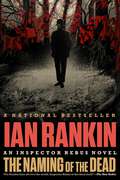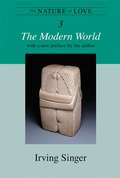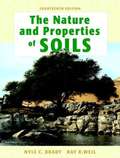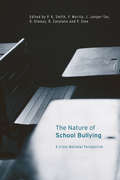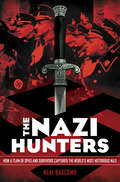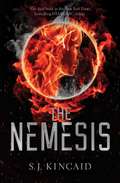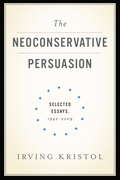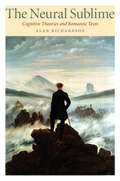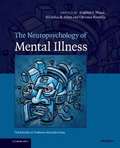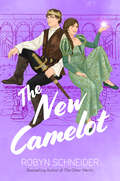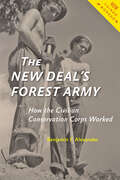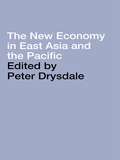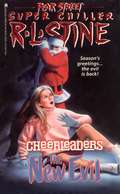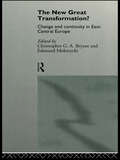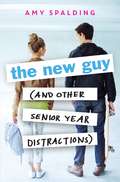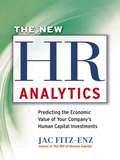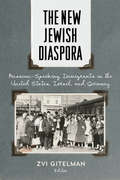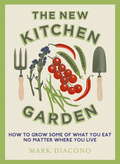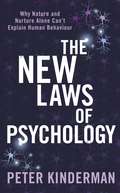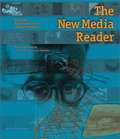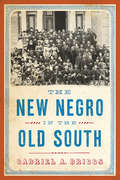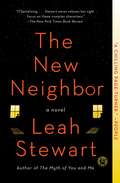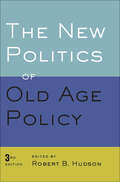- Table View
- List View
The Naming of the Dead: An Inspector Rebus Novel (Inspector Rebus #16)
by Ian RankinThe leaders of the free world descend on Scotland for an international conference, and every cop in the country is needed for front-line duty...except one. John Rebus's reputation precedes him, and his bosses don't want him anywhere near Presidents Bush and Putin, which explains why he's manning an abandoned police station when a call comes in. During a preconference dinner at Edinburgh Castle, a delegate has fallen to his death. Accident, suicide, or something altogether more sinister? And is it linked to a grisly find close to the site of the gathering? Are the world's most powerful men at risk from a killer? While the government and secret services attempt to hush the whole thing up, Rebus knows he has only seventy-two hours to find the answers.
The Nature Of Love: The Modern World
by Irving SingerIn the third volume, Singer examines the pervasive dialectic between optimistic idealism and pessimistic realism in modern thinking about the nature of love. He begins by discussing "anti-Romantic Romantics" (focusing on Kierkegaard, Nietzsche, and Tolstoy), influential nineteenth-century thinkers whose views illustrate much of the ambiguity and self-contradiction that permeate thinking about love in the last hundred years. He offers detailed studies of Freud, Proust, Shaw, D. H. Lawrence, and Santayana, and he maps the ideas about love in Continental existentialism, particularly those of Sartre and de Beauvoir. Singer finally envisages a future of cooperation between pluralistic humanists and empirical scientists. This last volume of Singer's trilogy does not pretend to offer the final word on the subject, any more than do most of the philosophers he discusses, but his masterful work can take its place beside their earlier investigations into these vast and complex questions. Irving Singer Library
The Nature and Properties of Soils
by Nyle C. Brady Ray R. WeilThe Nature and Property of Soils is an engaging book for readers. It has an ecological approach that explains the fundamentals of soil science effectively. Chapter topics include Soil Erosion and Its Control, Soil Acidity, Soils and Chemical Pollution, and Organisms and the Ecology of the Soil. For individuals interested in soil and the environment.
The Nature of School Bullying: A Cross-National Perspective
by P. K. Smith Y. Morita J. Junger-Tas D. Olweus R. Catalano P. SleeThe Nature of School Bullying provides a unique world-wide perspective on how different countries have conceptualized the issue of school bullying, what information has been gathered, and what interventions have been carried out. Written and compiled by well known experts in the field, it provides a concise summary of the current state of knowledge of school bullying in nineteen different countries, including: * demographic details * definitions of bullying * the nature and types of school bullying * descriptive statistics about bullying * initiatives and interventions. The Nature of School Bullying provides an authoritative resource for anyone interested in ways in which this problem is being tackled on a global scale. It will be invaluable for teachers, educational policy makers, researchers, and all those concerned with understanding school bullying and finding ways of dealing with it.
The Nazi Hunters: How A Team Of Spies And Survivors Captured The World's Most Notorious Nazi
by Neal BascombA thrilling spy mission, a moving Holocaust story, and a first-class work of narrative nonfiction.This Sydney Taylor Book Award- and YALSA Excellence in Nonfiction Award-winning story of Eichmann's capture is now a major motion picture starring Oscar Isaac and Ben Kingsley, Operation Finale!In 1945, at the end of World War II, Adolf Eichmann, the head of operations for the Nazis' Final Solution, walked into the mountains of Germany and vanished from view. Sixteen years later, an elite team of spies captured him at a bus stop in Argentina and smuggled him to Israel, resulting in one of the century's most important trials -- one that cemented the Holocaust in the public imagination.This is the thrilling and fascinating story of what happened between these two events. Illustrated with powerful photos throughout, impeccably researched, and told with powerful precision, THE NAZI HUNTERS is a can't-miss work of narrative nonfiction for middle-grade and YA readers.
The Nemesis: The Diabolic; The Empress; The Nemesis (The Diabolic #3)
by S. J. KincaidIn the &“intense and captivating&” (Kirkus Reviews) conclusion to the New York Times bestselling Diabolic series, the Empire teeters on the edge of destruction as rumors spread that Nemesis is still alive.Three years ago, Tyrus Domitrian shocked the galaxy by killing the woman he swore to love forever. The woman for whom he upended the Empire. The woman with whom he wanted to build a new and brighter future. Now, the once-idealistic heir apparent has become the cruel Emperor Tyrus, wielding his authority with an iron fist, capable of destroying planets with a single word, controlling all technology with a simple thought. He has bent the Grandiloquy to their knees, and none has the power to stand against him. But there is a muttering among the Excess. They say that Nemesis is not truly gone. They whisper of her shadow spotted in distant star systems. They say that Nemesis lives. That she will rise and rally the people to topple the man who was once her truest love—and is now her fiercest enemy.
The Neoconservative Persuasion: Selected Essays, 1942-2009
by Irving KristolFrom the late founder of neoconservatism, a wide-ranging collection of his best writings
The Neural Sublime: Cognitive Theories and Romantic Texts
by Alan RichardsonWinner, 2011 Alpha Sigma Nu Book Award in Literature and Fine ArtsThe Neural Sublime brings recent work in cognitive neuroscience to bear on some famously vexed issues in British Romantic studies. In exciting and unprecedented ways, Alan Richardson demonstrates how developments in the neurosciences can transform the study of literary history. Richardson presents six exemplary studies, each exploring a different intersection of Romanticism and the sciences of the mind and brain: the experience of the sublime and the neuroscience of illusion; the Romantic imagination and visual imaging; the figure of apostrophe and linguistic theory; fictional representations of the mind and "theory of mind" theory; depictions of sibling incest and neo-Darwinian theories of mental behavior; and representations of female speech and cognitive developmental psychology. Richardson’s insightful analysis opens fresh perspectives on British Romanticism, pointing scholars to new developments in cognitive literary studies. He combines elements of new historicist analysis with original—and much-needed—models for understanding language, subjectivity, and social behavior. Far from signaling a departure from the prevalent critical approaches of new historicism, Richardson argues, cognitive theory presents an essential complement to them.The Neural Sublime features an array of cognitive and neuroscientific approaches, providing an engaging and readable introduction to the emergent field of cognitive literary studies.
The Neuropsychology of Mental Illness
by Stephen J. Wood Nicholas B. Allen Christos PantelisIt is widely accepted that most psychiatric disorders are associated with cognitive impairment and that neuropsychological approaches can help unravel the mechanisms underlying brain function and help us develop a better understanding of these disorders. In this book, a panel of the world's leading experts describe the development of neuropsychological approaches to the investigation, description, measurement and management of a wide range of mental illnesses. Part One explains the rationale for examining neuropsychological processes within clinical disorders, leading into Part Two summarizing and critiquing the methodological approaches to study. Part Three covers each of the major psychiatric disorders and provides a summary of the neuropsychological findings for each condition. The final section brings together the perspectives of neuroscientists, psychiatrists and philosophers. Essential reading for all those studying the healthy as well as the disordered brain, The Neuropsychology of Mental Illness will appeal to specialists from the fields of mental health, psychology, clinical neuroscience and philosophy.
The New Camelot (Emry Merlin #3)
by Robyn SchneiderSayeth it ain't so! The finale to the epic Emry Merlin trilogy is here, with all the sorcery, snark, and high stakes that made The Other Merlin one of Publishers Weekly&’s Best Books of the Year!Everything is finally going right for Emry Merlin. Now that Arthur is the king and her wayward magic is under control, she&’s enjoying life as Camelot&’s official court wizard—and as Arthur&’s girlfriend.But when an unexpected visitor arrives at court, Emry finds her hard-won position threatened. And Arthur is torn between listening to his advisors and following his heart. Even more troubling, war is on the horizon, with King Yurien&’s access to dark magic ensuring Camelot&’s doom. That is, unless Emry, Arthur, and Lance can find a way to defeat the evil sorceress Bellicent with magic from her own world. But undertaking a quest to Anwen is perilous business, and our young heroes will face many obstacles on their journey—from dangerous beasts to suspicious nobles to cursed maidens determined to find someone to marry.Can Emry and Arthur save their kingdom and fix their relationship, or will they have to choose between their future and Camelot&’s?
The New Deal's Forest Army: How the Civilian Conservation Corps Worked (How Things Worked)
by Benjamin F. AlexanderHow the Civilian Conservation Corps constructed, rejuvenated, and protected American forests and parks at the height of the Great Depression.Propelled by the unprecedented poverty of the Great Depression, President Franklin D. Roosevelt established an array of massive public works programs designed to provide direct relief to America’s poor and unemployed. The New Deal’s most tangible legacy may be the Civilian Conservation Corps’s network of parks, national forests, scenic roadways, and picnic shelters that still mark the country’s landscape. CCC enrollees, most of them unmarried young men, lived in camps run by the Army and worked hard for wages (most of which they had to send home to their families) to preserve America’s natural treasures. In The New Deal’s Forest Army, Benjamin F. Alexander chronicles how the corps came about, the process applicants went through to get in, and what jobs they actually did. He also explains how the camps and the work sites were run, how enrollees spent their leisure time, and how World War II brought the CCC to its end. Connecting the story of the CCC with the Roosevelt administration’s larger initiatives, Alexander describes how FDR’s policies constituted a mixed blessing for African Americans who, even while singled out for harsh treatment, benefited enough from the New Deal to become an increasingly strong part of the electorate behind the Democratic Party. The CCC was the only large-scale employment program whose existence FDR foreshadowed in speeches during the 1932 campaign—and the dearest to his heart throughout the decade that it lasted. Alexander reveals how the work itself left a lasting imprint on the country’s terrain as the enrollees planted trees, fought forest fires, landscaped public parks, restored historic battlegrounds, and constructed dams and terraces to prevent floods. A uniquely detailed exploration of life in the CCC, The New Deal’s Forest Army compellingly demonstrates how one New Deal program changed America and gave birth to both contemporary forestry and the modern environmental movement.
The New Economy in East Asia and the Pacific (PAFTAD (Pacific Trade and Development Conference Series) #10)
by Peter DrysdaleThis book sets out the problems of measuring the effects of technological change on economic progress by using the internet in the Asia-Pacific region as a case study. Corporate and industry experience, including changing business organization and new regulatory issues are explored as well as policy issues such as the digital divide and the approach to e-commerce in the WTO. Using several industry case studies the contributors compare the IT experience in North America with a number of countries in Asia and the Pacific.
The New Evil (Fear Street Cheerleaders)
by R.L. StineCorky and the Shadyside cheerleaders are sure that the evil spirit is destroyed. The terror is over. Then Hannah is mysteriously thrown through the car window. And Naomi is nearly burned to death. One horrifying accident after another. And now Corky can no longer keep her greatest fear to herself—the evil is back! But where is it? Corky, Kimmy, and Debra aren’t waiting to find out. They have a plan to draw the evil out and destroy it for good. Unless, of course, the evil destroys them first...
The New Great Transformation?: Change and Continuity in East-Central Europe
by Christopher G.A. Bryant Edmund MokrzyckiThis timely and assured book provides an essential guide to one of the biggest social, political and economic developments of our time.
The New Guy (and Other Senior Year Distractions)
by Amy SpaldingFilled with romance, rivalry, and passive-aggressive dog walking, Amy Spalding delivers a hilariously relatable story about how even the best-laid plans sometimes need to be rewritten.What's the only thing that could derail overachiever Jules's perfect senior year? Alex Powell--former member of boy-band sensation Chaos 4 All and newest transfer to Eagle Vista Academy. Alex seems cool enough when he starts spending time with Jules. In fact, he turns out to be quite the romantic (not to mention a killer kisser). And after getting over the initial shock that someone like Alex might actually like like her, Jules accepts that having a boyfriend could be a nice addition to her packed schedule. That is, until Alex commits the ultimate betrayal, which threatens to ruin her high school career, and possibly her entire future. This. Means. War.
The New HR Analytics: Predicting the EconomicValue of Your Company's Human Capital Investments
by Jac FITZ-ENZUsing Fitz-enz&’s proprietary analytic model, you will be equipped to measure and evaluate past and current returns and apply the information to make predictions about the future value of human capital investments.In his landmark book, The ROI of Human Capital, Jac Fitz-enz presented a system of powerful metrics for quantifying the contributions of individual employees to a company&’s bottom line. Now, in The New HR Analytics, he reveals how human resources professionals can apply this expense-based knowledge to make the most strategic staffing decisions for their companies.You&’ll learn how to:evaluate and prioritize the skills needed to sustain performance;build an agile workforce through flexible Capability Planning;determine how the organization can stimulate and reward behaviors that matter;apply a proven succession planning strategy that leverages employee engagement and drives top-line revenue growth;and recognize risks and formulate responses that avoid surprises.Brimming with real-world examples and input from thirty top HR practitioners and thought leaders as well as exclusive analytical tools, The New HR Analytics ushers in a new era in human resources and human capital management.
The New Jewish Diaspora: Russian-Speaking Immigrants in the United States, Israel, and Germany
by Zvi Gitelman Mikhail Krutikov Stephanie Sandler Anna Shternshis Sveta Roberman Uzi Rebhun Jonathan Dekel-Chen Adrian Wanner Nelly Elias Steven J. Gold Mark Tolts Hannah Pollin-Galay Julia Lerner Marina Sapritsky Elena Nosenko-Shtein Olena Bagno-Moldavski Eliezer Ben-Rafael Gur Ofer Yaacov Ro'IIn 1900 over five million Jews lived in the Russian empire; today, there are four times as many Russian-speaking Jews residing outside the former Soviet Union than there are in that region. The New Jewish Diaspora is the first English-language study of the Russian-speaking Jewish diaspora. This migration has made deep marks on the social, cultural, and political terrain of many countries, in particular the United States, Israel, and Germany. The contributors examine the varied ways these immigrants have adapted to new environments, while identifying the common cultural bonds that continue to unite them. Assembling an international array of experts on the Soviet and post-Soviet Jewish diaspora, the book makes room for a wide range of scholarly approaches, allowing readers to appreciate the significance of this migration from many different angles. Some chapters offer data-driven analyses that seek to quantify the impact Russian-speaking Jewish populations are making in their adoptive countries and their adaptations there. Others take a more ethnographic approach, using interviews and observations to determine how these immigrants integrate their old traditions and affiliations into their new identities. Further chapters examine how, despite the oceans separating them, members of this diaspora form imagined communities within cyberspace and through literature, enabling them to keep their shared culture alive. Above all, the scholars in The New Jewish Diaspora place the migration of Russian-speaking Jews in its historical and social contexts, showing where it fits within the larger historic saga of the Jewish diaspora, exploring its dynamic engagement with the contemporary world, and pointing to future paths these immigrants and their descendants might follow.
The New Kitchen Garden: The Ultimate Kitchen Garden Guide
by Mark DiaconoLook over the fences into the gardens, patios, courtyards and allotments behind, and you'll see a quiet revolution taking place. Amongst the lawns, the roses and the concrete, more and more of us are growing at least some of what we eat. A kitchen garden can be anything from a collection of pots to a small farm - it all depends on where you live and what space you have to create your own edible plot. The New Kitchen Garden doesn't begin with the usual plan of an allotment quartered into beds awaiting their rotation, it starts by asking what you need from your garden. What follows is a series of invitations - fruits, nuts, herbs, spices, flowers and vegetables to grow and eat. Everything is here - the tools, the techniques, the ideas and the knowledge - to enable you to realise that vision of your own kitchen garden. Mark Diacono - who was head of the gardening team at Hugh Fearnley-Whittingstall's River Cottage - captures the spirit of adventure and imagination of those growing food in the twenty-first century. He takes ideas from gardens around the world, including that of his own home, Otter Farm in Devon, with its unique blend of orchards, vineyards, forest gardens, edible hedges, perennial garden and veg patch. Inspired by a range of gardeners growing food on allotments, on rooftops, in container gardens and in other edible spaces, many of them urban, Mark shows you the full exciting breadth of what a kitchen garden can be. Whether you have a few pots of chillies or a community farm, whether you wish to plant in ordered rows or create an edible jungle, The New Kitchen Garden is for you.
The New Laws of Psychology: Why Nature And Nurture Alone Can't Explain Human Behaviour
by Peter KindermanThis controversial new book describes how human behaviour - thoughts, emotions, actions and mental health - can be largely explained if we understand how people make sense of their world and how that framework of understanding has been learned. In this ground-breaking book, Peter Kinderman, presents a simple, but radical new model of mental well-being. Published following the publication of the new edition of the controversial, Diagnostic and Statistical Manual, the author challenges notions such as 'mental illness' and 'abnormal psychology' as old-fashioned, demeaning and invalid, and argues that diagnoses such as 'depression' and 'schizophrenia' are unhelpful. Kinderman argues that one consequence of our current obsession with a medical approach to human well-being and distress, is that human problems are too often merely diagnosed and treated, rather than understood. Witten by an expert in his field, and accessible to all those interested in and affected by mental health issues, The New Laws of Psychology will change the way we define mental illness forever.
The New Laws of Psychology: Why Nature and Nurture Alone Can't Explain Human Behaviour
by Peter KindermanThis controversial new book describes how human behaviour - thoughts, emotions, actions and mental health - can be largely explained if we understand how people make sense of their world and how that framework of understanding has been learned. In this ground-breaking book, Peter Kinderman, presents a simple, but radical new model of mental well-being. Published following the publication of the new edition of the controversial, Diagnostic and Statistical Manual, the author challenges notions such as 'mental illness' and 'abnormal psychology' as old-fashioned, demeaning and invalid, and argues that diagnoses such as 'depression' and 'schizophrenia' are unhelpful. Kinderman argues that one consequence of our current obsession with a medical approach to human well-being and distress, is that human problems are too often merely diagnosed and treated, rather than understood. Written by an expert in his field, and accessible to all those interested in and affected by mental health issues, The New Laws of Psychology will change the way we define mental illness forever.
The New Media Reader
by Nick Montfort Noah Wardrip-FruinThis reader collects the texts, videos, and computer programs--many of them now almost impossible to find--that chronicle the history and form the foundation of the still-emerging field of new media. General introductions by Janet Murray and Lev Manovich, along with short introductions to each of the texts, place the works in their historical context and explain their significance. The texts were originally published between World War II--when digital computing, cybernetic feedback, and early notions of hypertext and the Internet first appeared--and the emergence of the World Wide Web--when they entered the mainstream of public life. The texts are by computer scientists, artists, architects, literary writers, interface designers, cultural critics, and individuals working across disciplines. The contributors include (chronologically) Jorge Luis Borges, Vannevar Bush, Alan Turing, Ivan Sutherland, William S. Burroughs, Ted Nelson, Italo Calvino, Marshall McLuhan, Billy Kl?Jean Baudrillard, Nicholas Negroponte, Alan Kay, Bill Viola, Sherry Turkle, Richard Stallman, Brenda Laurel, Langdon Winner, Robert Coover, and Tim Berners-Lee. The CD accompanying the book contains examples of early games, digital art, independent literary efforts, software created at universities, and home-computer commercial software. Also on the CD is digitized video, documenting new media programs and artwork for which no operational version exists. One example is a video record of Douglas Engelbart's first presentation of the mouse, word processor, hyperlink, computer-supported cooperative work, video conferencing, and the dividing up of the screen we now call non-overlapping windows; another is documentation of Lynn Hershman's Lorna, the first interactive video art installation.
The New Negro in the Old South
by Gabriel A. BriggsStandard narratives of early twentieth-century African American history credit the Great Migration of southern blacks to northern metropolises for the emergence of the New Negro, an educated, upwardly mobile sophisticate very different from his forebears. Yet this conventional history overlooks the cultural accomplishments of an earlier generation, in the black communities that flourished within southern cities immediately after Reconstruction. In this groundbreaking historical study, Gabriel A. Briggs makes the compelling case that the New Negro first emerged long before the Great Migration to the North. The New Negro in the Old South reconstructs the vibrant black community that developed in Nashville after the Civil War, demonstrating how it played a pivotal role in shaping the economic, intellectual, social, and political lives of African Americans in subsequent decades. Drawing from extensive archival research, Briggs investigates what made Nashville so unique and reveals how it served as a formative environment for major black intellectuals like Sutton Griggs and W. E. B. Du Bois. The New Negro in the Old South makes the past come alive as it vividly recounts little-remembered episodes in black history, from the migration of Colored Infantry veterans in the late 1860s to the Fisk University protests of 1925. Along the way, it gives readers a new appreciation for the sophistication, determination, and bravery of African Americans in the decades between the Civil War and the Harlem Renaissance.
The New Negro in the Old South
by Gabriel A. BriggsStandard narratives of early twentieth-century African American history credit the Great Migration of southern blacks to northern metropolises for the emergence of the New Negro, an educated, upwardly mobile sophisticate very different from his forebears. Yet this conventional history overlooks the cultural accomplishments of an earlier generation, in the black communities that flourished within southern cities immediately after Reconstruction. In this groundbreaking historical study, Gabriel A. Briggs makes the compelling case that the New Negro first emerged long before the Great Migration to the North. The New Negro in the Old South reconstructs the vibrant black community that developed in Nashville after the Civil War, demonstrating how it played a pivotal role in shaping the economic, intellectual, social, and political lives of African Americans in subsequent decades. Drawing from extensive archival research, Briggs investigates what made Nashville so unique and reveals how it served as a formative environment for major black intellectuals like Sutton Griggs and W.E.B. Du Bois. The New Negro in the Old South makes the past come alive as it vividly recounts little-remembered episodes in black history, from the migration of Colored Infantry veterans in the late 1860s to the Fisk University protests of 1925. Along the way, it gives readers a new appreciation for the sophistication, determination, and bravery of African Americans in the decades between the Civil War and the Harlem Renaissance.
The New Neighbor: A Novel
by Leah StewartIn the tradition of Zoe Heller's What Was She Thinking? Notes on a Scandal, The New Neighbor is a darkly sophisticated novel about an old woman's curiosity turned into a dangerous obsession as she becomes involved in her new neighbor's complicated and cloaked life.Ninety-year-old Margaret Riley is content hiding from the world. Stoic and independent, she rarely leaves the Tennessee mountaintop where she lives, finding comfort in the mystery novels that keep her company, that is, until she spots a woman who's moved into the long-empty house across the pond. Jennifer Young is also looking to hide. On the run from her old life, she and her four-year-old son Milo have moved to a quiet town where no one from her past can find her. In Jennifer, Margaret sees both a potential companion in her loneliness and a mystery to be solved. But Jennifer refuses to talk about herself, her son, his missing father, or her past. Frustrated, Margaret crosses more and more boundaries in pursuit of the truth, threatening to unravel the new life Jennifer has so painstakingly created--and reveal some secrets of her own.
The New Politics of Old Age Policy
by Robert B. HudsonA comprehensive overview of current aging policies.As the average age of the U.S. population continues to increase, age-related policies have come under intense scrutiny, sparking heated debates. In the past, older people were seen as a frail, dependent population, but major policies enacted or expanded on their behalf have made them major players in electoral and interest-group politics. This thoroughly revised and updated edition of Robert B. Hudson’s The New Politics of Old Age Policy not only explains the politics behind the country’s age-based programs and describes how those programs work but also assesses how well—or poorly—they meet the growing and changing needs of older Americans. Essays by leading experts in political science, sociology, law, social work, and gerontology address, among other things, theoretical approaches to age-based policy; population dynamics and the impact of growing diversity within the older population; and national, state, and local issues associated with major age-based programs. More than any other source, this book presents the most current information on growing older in the United States, including in-depth analyses of Social Security, Medicare, Medicaid, housing initiatives, the Older Americans Act, the Age Discrimination in Employment Act, and tax policy.Detailed new chapters focus on financial security and retirement in the context of the Great Recession, diversity and inequality in aging populations, and implications of the Affordable Care Act. Scholars, students, and policymakers will appreciate the volume’s timely overview of the evolution of aging policy.
